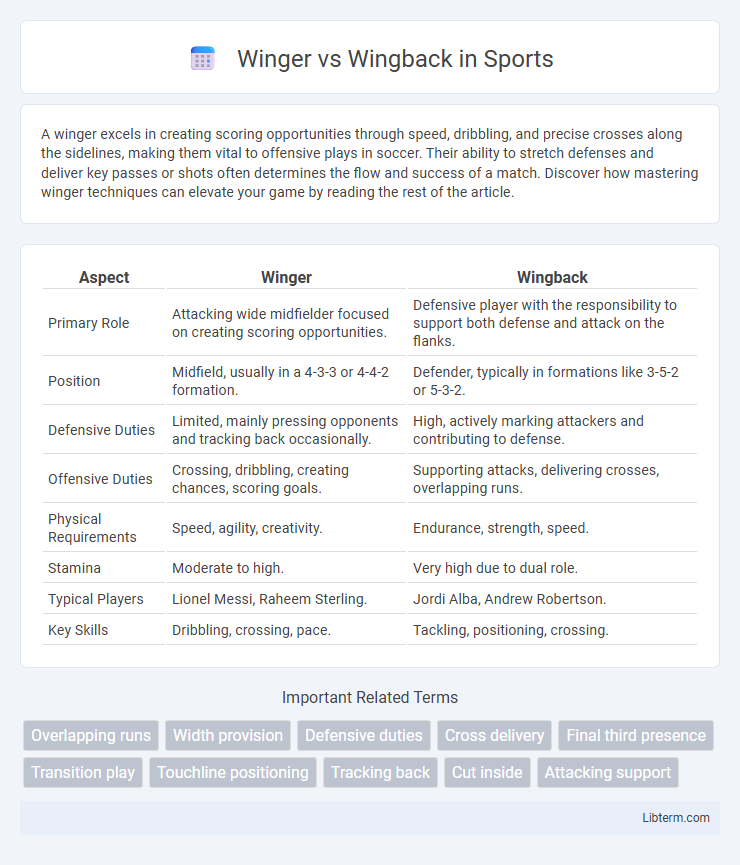A winger excels in creating scoring opportunities through speed, dribbling, and precise crosses along the sidelines, making them vital to offensive plays in soccer. Their ability to stretch defenses and deliver key passes or shots often determines the flow and success of a match. Discover how mastering winger techniques can elevate your game by reading the rest of the article.
Table of Comparison
| Aspect | Winger | Wingback |
|---|---|---|
| Primary Role | Attacking wide midfielder focused on creating scoring opportunities. | Defensive player with the responsibility to support both defense and attack on the flanks. |
| Position | Midfield, usually in a 4-3-3 or 4-4-2 formation. | Defender, typically in formations like 3-5-2 or 5-3-2. |
| Defensive Duties | Limited, mainly pressing opponents and tracking back occasionally. | High, actively marking attackers and contributing to defense. |
| Offensive Duties | Crossing, dribbling, creating chances, scoring goals. | Supporting attacks, delivering crosses, overlapping runs. |
| Physical Requirements | Speed, agility, creativity. | Endurance, strength, speed. |
| Stamina | Moderate to high. | Very high due to dual role. |
| Typical Players | Lionel Messi, Raheem Sterling. | Jordi Alba, Andrew Robertson. |
| Key Skills | Dribbling, crossing, pace. | Tackling, positioning, crossing. |
Definition of Winger and Wingback
A winger is an attacking football player positioned near the touchlines whose primary role is to deliver crosses, create scoring opportunities, and use speed and dribbling to beat defenders. A wingback combines the roles of a fullback and winger with responsibilities both in defense, such as marking and tackling, and in attack, providing width and overlapping runs. Wingbacks typically operate in formations with three central defenders, enabling them to advance higher up the pitch while maintaining defensive duties.
Primary Roles on the Field
Wingers primarily focus on offensive roles, using their speed and dribbling skills to create scoring opportunities by delivering crosses and cutting inside to shoot. Wingbacks balance defensive and offensive duties, acting as wide defenders who support attacks by overlapping wingers and tracking back to defend against opposition wingers. Their role demands high stamina and tactical awareness to maintain width and contribute effectively at both ends of the pitch.
Key Differences in Positioning
Wingers primarily operate high and wide on the flanks, focusing on attacking roles such as delivering crosses, dribbling past defenders, and creating scoring opportunities near the opponent's penalty box. Wingbacks combine defensive and offensive responsibilities, positioning themselves deeper along the sidelines to provide defensive cover while also supporting forward play with overlapping runs. The key difference in positioning lies in the winger's advanced, attack-oriented placement versus the wingback's more balanced role that demands both defensive solidity and offensive contribution.
Essential Skills for Wingers vs Wingbacks
Wingers require excellent dribbling, pace, and crossing abilities to create scoring opportunities and stretch the opponent's defense on the flanks. Wingbacks must combine defensive skills like tackling and positional awareness with offensive attributes such as stamina and accurate passing to support both defense and attack. Mastery in one-on-one situations and spatial awareness differentiates wingers' attacking focus from wingbacks' dual-role responsibilities.
Defensive Responsibilities
Wingbacks possess greater defensive responsibilities than wingers, often required to track back and support the full-backs in one-on-one duels and positional defending. Wingers primarily focus on offensive duties such as dribbling, crossing, and creating goal-scoring opportunities, with limited defensive tracking. Wingbacks operate within formations like 3-5-2, balancing attack and defense, whereas wingers function in traditional 4-3-3 or 4-4-2 setups with less defensive burden.
Offensive Contributions
Wingers primarily contribute to offensive play by delivering crosses, creating scoring opportunities, and dribbling past defenders along the flanks, often staying high and wide to stretch the opposition's defense. Wingbacks combine defensive duties with attacking support, frequently overlapping with midfielders and forwards to provide width, deliver precise crosses, and contribute to goal-scoring chances through incisive runs into the final third. Both roles demand pace and technical skill, but wingbacks tend to engage more in transitional play, whereas wingers focus on sustained offensive pressure.
Tactical Importance in Modern Football
Wingers primarily focus on creating width and delivering crosses, crucial for stretching defenses and supporting forwards in goal-scoring opportunities. Wingbacks combine defensive duties with attacking support, providing tactical flexibility by linking midfield and defense while maintaining width in both phases of play. Modern football leverages wingbacks in formations like 3-5-2 for overloads on flanks, whereas wingers thrive in 4-3-3 or 4-2-3-1 systems to exploit wide spaces and accelerate counterattacks.
Famous Wingers and Wingbacks
Famous wingers like Cristiano Ronaldo and Arjen Robben are renowned for their speed, dribbling skills, and goal-scoring ability, primarily operating along the attacking flanks in formations such as 4-3-3. Iconic wingbacks like Cafu and Dani Alves excel in a dual role, combining defensive responsibilities with offensive support in systems like 3-5-2 or 5-3-2, providing crosses and aiding counterattacks. Both roles demand high stamina and tactical awareness but differ significantly, with wingers focusing on offensive width and wingbacks balancing defense and attack.
Formation Impact on Roles
In football formations, wingers typically operate in a 4-3-3 or 4-2-3-1 setup, emphasizing offensive width and creativity, focusing on providing crosses and dribbling past defenders. Wingbacks fit prominently in formations like 3-5-2 or 5-3-2, combining defensive duties with attacking support along the flanks, requiring high stamina to cover the entire side. The choice between winger and wingback directly impacts team shape, defensive solidity, and attacking dynamics based on tactical priorities.
Choosing Between a Winger and a Wingback
Choosing between a winger and a wingback depends on the team's tactical formation and defensive requirements. Wingers prioritize attacking width and creativity, often focusing on delivering crosses and creating scoring opportunities, while wingbacks combine offensive support with defensive responsibilities, providing balance along the flanks. Coaches must assess player stamina, defensive skills, and the need for overlapping runs to determine the optimal role for each match strategy.
Winger Infographic

 libterm.com
libterm.com